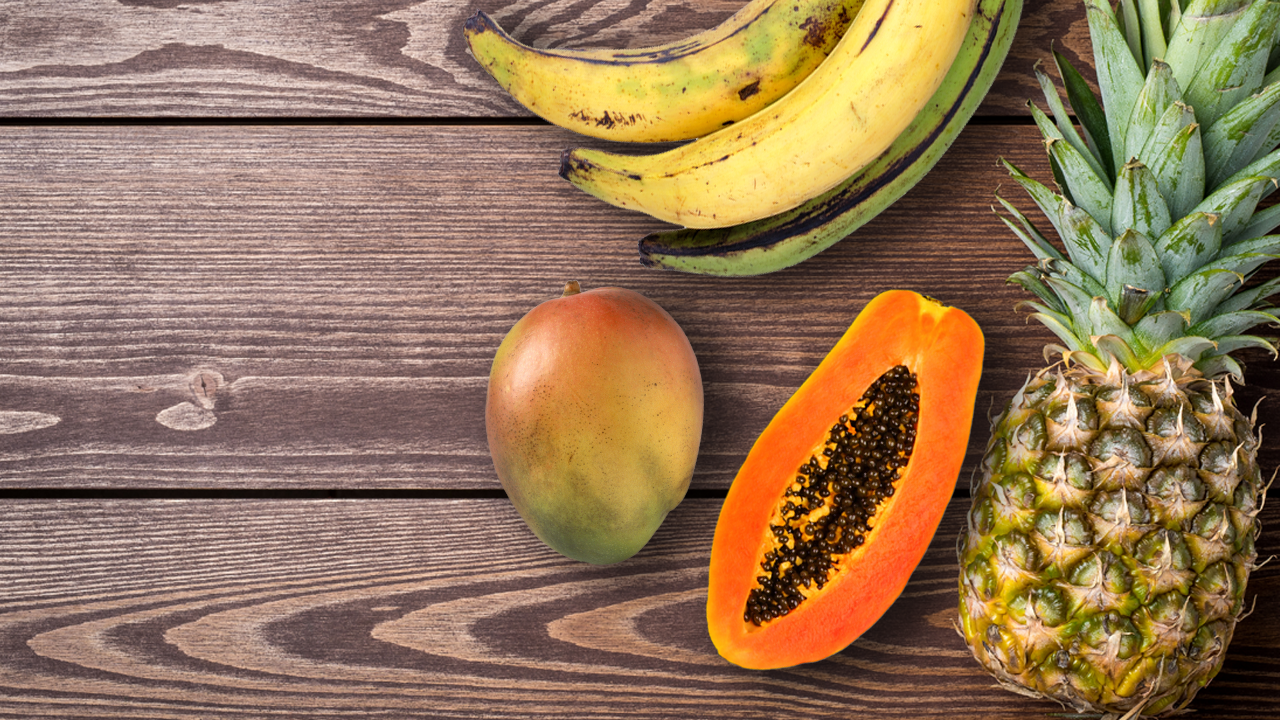
Produce 101: Tropical Fruit
Dan talks to us about Produce 101: Tropical Fruit
Tropical fruits are an amazing family of produce items. So, what designates a tropical fruit? The short answer is that they are any fruit that grows in the regions between the Tropics of Cancer and Capricorn, though many varieties have adapted to sub-tropical regions as well. We are going to focus on the big four in this Produce 101: Tropical Fruit–and they are mangos, papayas, and pineapples, and plantain.
Produce 101: Tropical Fruit — Pineapple
Pineapple has an association with the state of Hawai’i. Interestingly enough, there is no commercial crop in Hawai’i. What is grown there is consumed locally and not shipped world-wide anymore. Most of the pineapples we see in the market come from Central America: Costa Rica, Guatemala, and Honduras in particular.
The only edible bromeliad, the pineapple has long been prized for its incredibly sweet flavor.
Fun fact: Each section on a pineapple is an individual berry.
How to Tell if a Pineapple is Ripe
There are many theories relating to how to tell if your pineapple is ripe, but for the pineapple, the nose knows.
A pineapple should have a sweet, tropical aroma and the flesh should yield slightly to gentle pressure. It should smell like a pineapple.
Shell Color is Not an Indicator of Ripeness
As the industry has evolved, agronomists and agricultural scientists have developed better varieties that mature while the skin remains green. In the early days, pineapples were shipped fully gold–which made them susceptible to damage because they were too soft. They just didn’t make that long journey.
Another misnomer is pulling on a crown leaf and smelling it. What you want to do instead is to notice the overall aroma of the pineapple, and if it smells like a delicious pineapple, that one is ripe and ready to eat—your nose doesn’t lie.
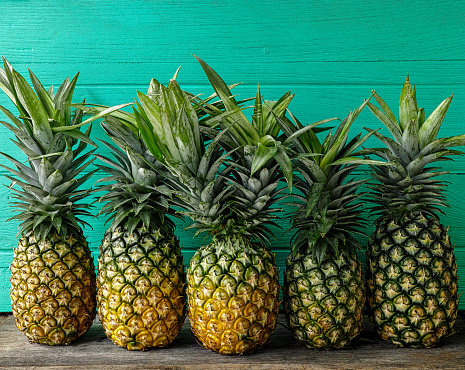
The leaves do help decide, but not by pulling them out. Look for green leaves and avoid fruit with brown or browning leaves, as that indicates the pineapple is a bit old. Unlike mangos and papayas, a pineapple will not ripen any further once they have been picked. Store pineapples between 45-55 degrees Fahrenheit, but not below 45 degrees. Avoid stacking heavy products on top of pineapples, as they are easily bruised.
Pineapple Grades
- Fancy: most common seen in the market
- #1
- #2
Pineapples, like papayas, can be used as a meat tenderizer as well, as they contain an enzyme known as bromelain. When you cut them up, save the cores, and use them as a meat tenderizer. Drop them in your marinade with a little brown sugar, red chile flakes, garlic, toasted sesame oil, and soy sauce—then thin it out with a water for an amazing tenderizing steak marinade.
When you are done processing your fruit, save the crown with about a half inch of fruit on it and plant it. In about three years you will have a delicious home-grown pineapple to eat.
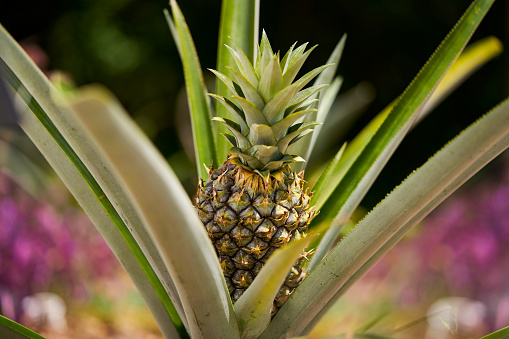
Produce 101: Tropical Fruit — Papayas
Papayas are Broken Up into Two Main Categories
- Maradol/Mexican: which are large with a green flesh
- Hawaiian/Sunrise: which are smaller and have a sweeter flesh
Both have similar flavors but often are used differently. Typically, papayas are packed and shipped on the green side, requiring the same type treatment as mangos to facilitate the ripening process.
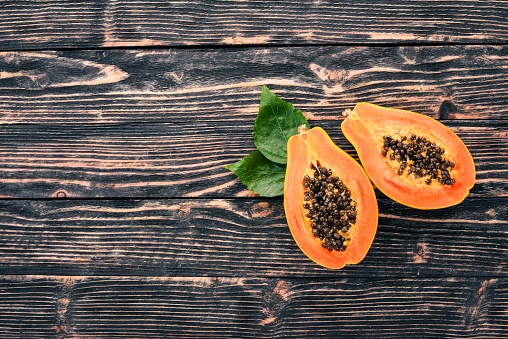
Mexican/Maradol Papayas
The Mexican papaya is primarily used in its immature green state—especially is southeast Asia, Thailand, and Vietnam in particular. It is shredded and combined with local citrus, chiles, and other ingredients to make a refreshing, light, crispy, slaw-type salad.
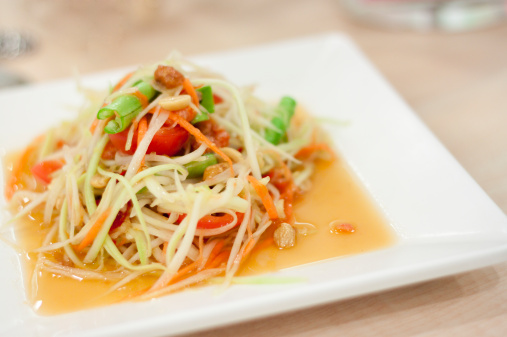
With some patience you can let these mature, they won’t be as sweet, but you can certainly use them. The skin of the papaya will tell you when it’s ready to go, as they will turn from a deep green to a vibrant orange/yellow color much like the Hawaiian/Sunrise papaya. There is a lot of flesh on these papayas, so this may be an economical alternative to use.
Hawaiian/Sunrise Papayas
The smaller Hawaiian/Sunrise-type papayas are typically sweeter and ripen a bit faster, they have a deeper orange flesh color, and are always used ripe. You can use them unripe as described above, but that might not be an economical choice over the Mexican variety.
Papayas contain an enzyme, papain, that breaks down protein and is an incredible meat tenderizer—much like pineapples. In addition, the seeds can be used as a seasoning, simply wash them, allow them to dry and grind them up. They add a wonderful peppery taste.
Produce 101: Tropical Fruit — Mangos
Mangos are one of the more popular tropical fruits, but they are also the trickiest to know when ripe.
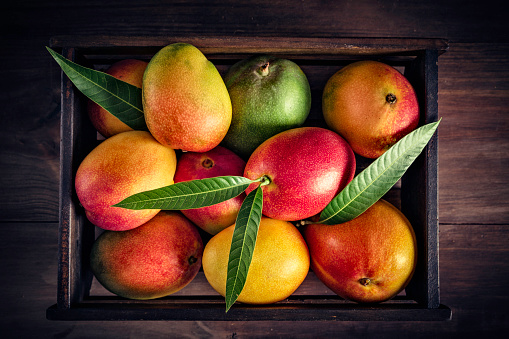
Don’t Go By Shell Color to Check Ripeness
If you see a green mango, that may not mean it is unripe. Some cultivars will remain green when fully ripe. And, some when picked are red, but immature.
How do you know if it is ripe?
If you don’t go by color, how do you know what to look for? The two best ways are by touch and smell, the skin color really won’t tell you much about the ripeness. Gently apply pressure to the stem end of the fruit, if it yields, the mango is ripe. Smell the mango, it should have an intensely sweet and tropical-floral aroma as well.
Mangos are grown in numerous countries and are typically available year-round. The varieties will change as we cycle through the season, but the handling, storage and use remain the same.
Mangos are shipped with a very firm to hard texture, and typically require a few days of conditioning to ripen.
How Do You Ripen a Mango?
Leave them out at room temperature for at least a day and let nature take its course. The optimal storage temperature is 55°F, as mangos are very susceptible to chill damage, but they can be frozen for up to 6 months if you come across a great crop of mangos. Just peel, dice, and freeze.
Good to know: Mangos are related to poison ivy, so if you’re allergic, take special care when handling the Mangos, as the skin can cause a similar allergic reaction.
Produce 101: Tropical Fruit — Plantains
Plantains are related to bananas, and look like a banana, but they are not a banana.
Plantains are used as starch substitutes. They are really potato-like and super starchy when green. When peeled, you can fry them, bake, steam, grill, or boil–they have a great starchy flavor. You can leave them out of the cooler when green and allow them to ripen to a yellow color, even almost black—known as Maduro.
It’s at this stage that they’re at their sweetest, but they never develop as much sugar as a hand fruit, such as a banana.
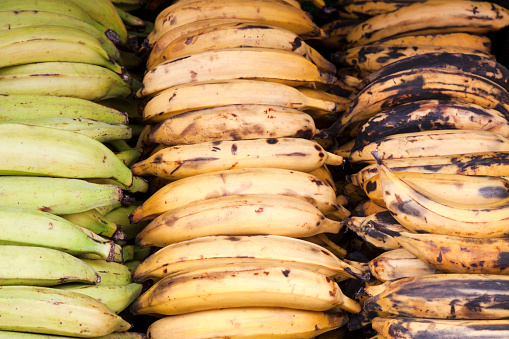
Plantains Are Always Cooked
While you can eat them uncooked, they just don’t taste great.
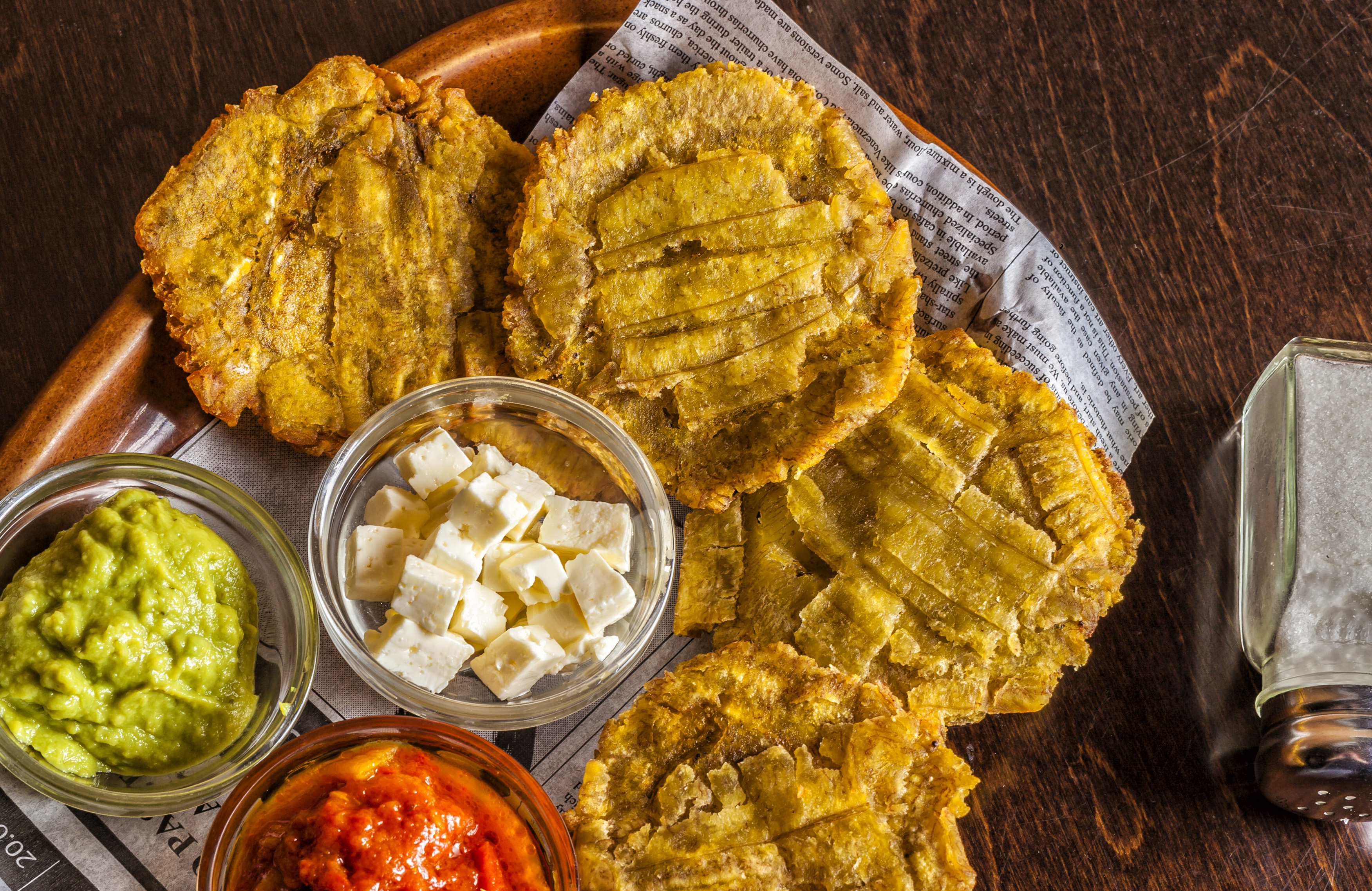
Grades of Plantains
Like other tropical fruit, there is no USDA grade spec for plantains, but there is a similar ripeness scale. A Stage 1 color plantain is solid green and extremely starchy and a Stage 6 color plantain is fully yellow and much sweeter, but it doesn’t stop there. Plantains can still be used even when the skin is nearly completely black.
Plantains are typically packed in 50# boxes, and often sold in a green or nearly complete green state.
Look for plantains that are firm to the touch and free of any visible decay, store them between 50-54°F, and away from ethylene producing fruits such as apples or pears. Avoid dropping the case, as they are prone to bruising.
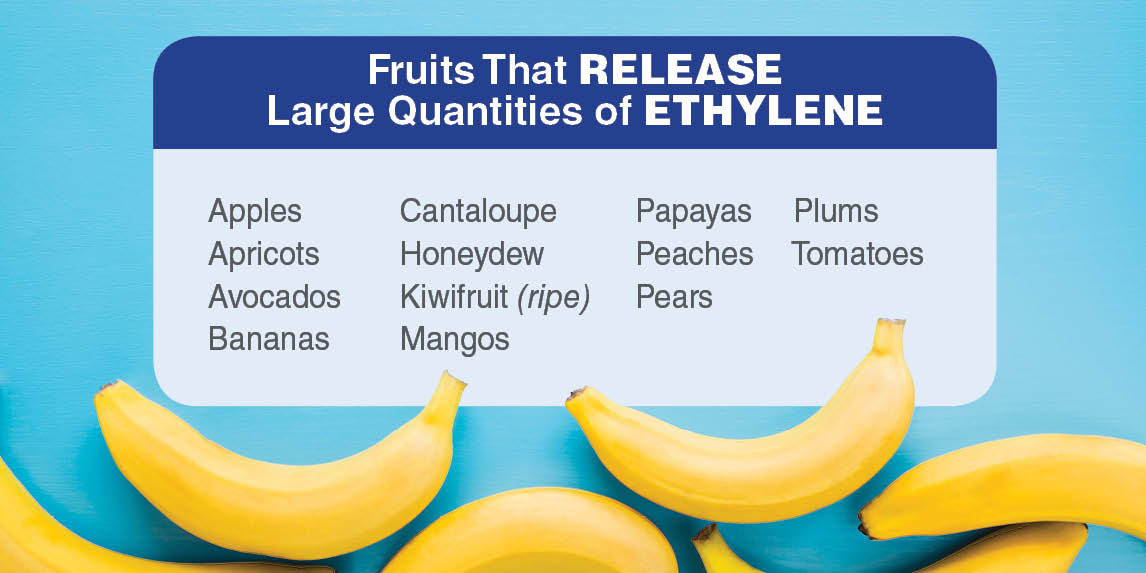
Like bananas, plantains are the berry of an herbaceous plant, and they actually don’t grow on trees. Trees have bark, these don’t.
How to Use Plantains
Green plantains are best utilized in savory applications, where yellow and even black plantains lend themselves to sweeter applications. Quick tip: if you need to ripen plantains quickly, bake them in a 300 degree Fahrenheit oven for 30-60 minutes and then allow them to cool.
Dan discusses the four most common tropical fruit we sell, and he helps you pick out the best one for your application:
Contact your Marketing Associate about adding tropical fruit to your next order. If you are not a customer, find out how to become one today!
Content provided by Chef Daniel Snowden, the Director of Culinary Development for FreshPoint Central Florida. He has been in the produce industry almost 20 years, and loves getting geeky about food. Additional contributions by Lisa Brizard.
Some tools you can use:
Visit freshpoint.com for our seasonal availability guides—and while you are there, check out the FreshPress, our latest market report. Place your orders online with ease at myfreshpoint.com. Did you know you can receive real-time reliable delivery alerts on the day of your delivery? Activate and subscribe at FreshPoint.com/mydelivery
Download our app and take your produce management on the go. Place orders, review flyers, watch videos…all in one spot!
Find out more details about our UBU program, and how we are shining a spotlight on food waste while making value and food safety a priority.
We buy local to strengthen regional economies, support family farms, preserve the local landscape, and to provide fresh-from-the-farm food to our customers. Local.freshpoint.com connects you to your local farmers like never before! Customize your search by zip, city, state, radius…even by crops and growing methods. Pop in your zip code and learn about our local farmers.
Socialize with us!
Did you know we are on YouTube? Head over to our page and check out our 75+ videos. Don’t forget to subscribe, and also be a part of our Bell Team—hit the little bell icon to get notifications when we upload new videos.
Follow FreshPoint, Inc. on Facebook, Twitter, Instagram, and LinkedIn…and follow The Produce Hunter on Instagram as she finds the best specialty produce at the Santa Monica Farmers Market.

